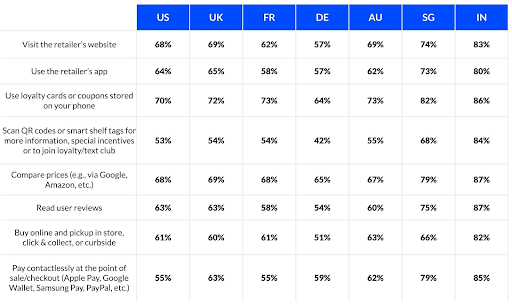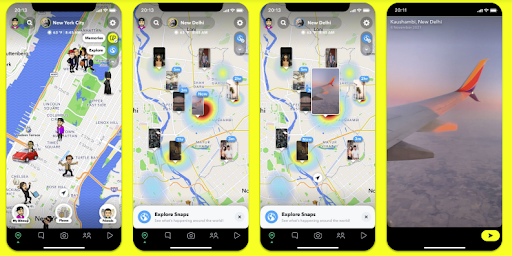Webinar Recap: Brand Loyalty Dies as Search, Social, and Reputation Converge
The Local Memo: 47 Percent of Consumers Will Turn to Smartphones for Holiday Shopping

In this week’s update, learn about consumer trends for the holidays; Facebook’s new data on emerging technology and commerce; several new Google Maps updates; Twitter and Search Engine Land discontinuing AMP; the November 2021 Core Update; and Snapchat’s new Snap Map “Layers.”
47% of Consumers Will Turn to Smartphones for Holiday Shopping
A large multinational survey conducted by Airship finds that nearly half of shoppers will use smartphones to shop online during the holiday season. Though a significant proportion of consumer attention is focused on e-commerce retailers, several survey responses indicate that shoppers will not neglect local businesses. In fact, 70% of U.S. respondents said they planned to use digital loyalty cards or coupons at stores; 53% plan to scan shelf tags and QR codes when viewing products in stores, in order to find more information or special incentives; 61% plan to buy online and pick up in-store, and 55% expect to use apps to pay contactlessly at the checkout counter. In addition, 63% of U.S. consumers said that user reviews will be an important component in shopping decisions. Margins are even higher in some other countries, in particular India where over 80% of respondents said they would engage in all of the above activities. Millennials are more likely to use apps in-store than any other demographic, with 81% saying they’re using retail apps either more than or about the same amount as before the pandemic.
Courtesy Business of Apps / Airship
Facebook Offers Insights on Emerging Shopping Behaviors
The new focus of Facebook (that is, of Meta) on virtual experiences as a component of commerce, which I’ve been discussing as a component of the strategic shifts that have coincided with the company’s rebranding, takes clearer shape with the release of a new report called “The New Era of Shopping is Hybrid.” The report covers several emerging retail trends and pays special attention to AR and VR. “Today’s consumers see no difference between online and offline channels,” in the words of the report. “It’s all just shopping. As the pandemic recedes, a new hybrid world of retail is emerging where the already blurred lines between physical and digital become even less distinct and shopping becomes a more interconnected experience.” Consumers, according to the report, are primarily interested in using technology to bridge the gap between online and offline shopping; to make in-store shopping more efficient; and for shopping experiences to be more exciting and human. Some cited stats include:- 72% of U.S. shoppers use at least one omnichannel pickup method (like BOPIS)
- 81% of U.S. shoppers make a purchase after discovering an item on social media
- 72% would like stores to offer QR codes to check product availability while in store
- 68% would like to pay for in-store purchases using a messaging app like Whatsapp
- 73% would like to use in-store augmented reality technology to experience products
- 72% would like stores to offer virtual reality headsets to help them experience products
Multiple Google Maps Updates in Time for the Holidays
Google has announced some new Google Maps features in time for the holiday season. As is often the case with these roundup-style updates from Google, some of these features were actually launched earlier in the year while others are in fact new. For those who want to check how busy public spaces will be before venturing out, Google now offers a live busyness report for neighborhoods and parts of town that is similar to the reports we’ve grown used to for busyness at stores, including variations by time of day. This feature has begun rolling out globally. A new Directory tab is also rolling out globally and will appear in listings for spaces with large interiors that are difficult to navigate, such as airports, shopping malls, and transit stations. The directory feature will help users navigate to stores, car rental kiosks, and other interior locations. Grocery pickup on Maps, which launched in a limited pilot earlier this year, is now rolling out to 2,000 Kroger Family grocery store locations in 30 states. Within the app, you can track your order status, share your ETA, and let the store know when you’ve arrived to pick up your order. Google is also rolling out user-reported price ranges for U.S. restaurants, along with more detailed review prompts designed to capture whether restaurants and cafes have features like outdoor seating, delivery options, and curbside pickup.
New restaurant price range feature, courtesy Google
According to a separate story, Google is also working to showcase food banks, pantries, and soup kitchens on Google Maps and Search in advance of the holidays. The company is working with information partners like WhyHunger and Hunger Free America and, in addition, has made some 85,000 phone calls to verify information directly with providers, focusing on those that don’t have a website.Twitter, Search Engine Land Dropping AMP
Some additional signs have appeared that indicate a gradual de-emphasis, or perhaps a slow demise, for accelerated mobile pages (AMP). As I’ve discussed in this space previously, the AMP format used to be the best way to guarantee top placement in Google’s mobile search results for news stories, with publishers in other arenas making use of the format as well in order to compete for eyeballs on mobile. But with the release of the Page Experience update this summer, Google is now allowing non-AMP pages to compete for top placement, and publishers are seeing AMP traffic decline. The news is now emerging that Twitter is discontinuing support for AMP by the end of this year. This doesn’t mean previous (or future) AMP links will break, but rather that Twitter will no longer send traffic to the AMP version of a page and will no longer promote the use of AMP in its recommendations to publishers. A bit closer to home, Search Engine Land has announced that it would stop publishing in the AMP format, a change which took effect last Friday. The announcement cites several reasons, including the headache of maintaining a separate AMP codebase, AMP’s lack of user analytics, and a significant drop in AMP traffic after Page Experience went live. Twitter’s move to discontinue AMP was also a part of the rationale, as the social network is one of Search Engine Land’s highest-volume referral sites.The November 2021 Core Update Is Live
Google’s November 2021 Core Update, the latest in a string of scheduled search algorithm updates this year, began rolling out on November 17. Some SEOs have expressed concern that Google was making an unusual move in rolling out a core update at the start of the holiday season; given that these updates typically take several days to fully roll out, this means that the November update may still be underway during Black Friday and Cyber Monday. However, Google’s Danny Sullivan posted on Twitter that most sites should not see a dramatic impact. Anyone nervous despite this reassurance about their site’s readiness to weather the storms of algorithm changes may want to check out Google’s new interactive SEO checklist.Snapchat Adds “Layers” to Snap Map
Snapchat continues to invest time and attention in local discovery, as evidenced by the release of a new “Layers” feature in Snap Map. Snap Map is the navigation tool within Snapchat that lets users look up the location of Snapchat friends, view stories from around the world, and discover local businesses and attractions. The Layers tool toggles the content displayed on the map, with options including Memories -- highlighting what you’ve shared and where over the last 12 months -- and Explore, which showcases public Snaps. Snapchat says it will soon release “Partnered Layers” enabling brands to sponsor map listings for nearby locations.
Snapchat Layers, courtesy Social Media Today
Subscribe to Local Memo!
Signup to receive Local memo updates and the latest on localized marketing, delivered weekly to your inbox.




